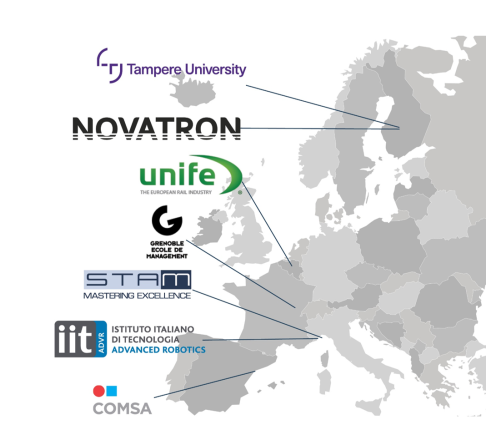Figures
Topic | S2R-OC-IP3-03-2020 |
EU Contributions | 2 700 000 € |
Duration | 30 months |
Project start date | 01/12/2020 |
Project end date | 31/05/2023 |
Partners | 7 partners from 5 countries |
Project coordinator | Dr. Christian Di Natali - Fondazione Istituto Italiano di Tecnologia |
Grant agreement | 101015418 |

Mission and Objectives
The rail industry is facing important challenges as the average age of the workforce keeps growing while less young workers are interested in the physically demanding work required. Smart technologies can help to reduce work demands, avoid incidents and accidents, and support workers during heavy activities. STREAM support LEAN execution of intelligent maintenance process by introducing technologies that cause negligible modification of current working procedures, yet strongly improve operation planning, safety and performance.
STREAM will deliver two methods to improve competitiveness in railway maintenance applications: (i) The development of new automated and smart working tools adapted to existing plants, together with autonomy enabling software functionality that uses robotics principles and Robot Operating System (ROS). This will introduce a level of autonomy and intelligence to OTMs. (ii) The deployment of a modular wearable exoskeleton to reduce the risk of injury by assisting workers in physically demanding activities. This will ultimately improve the worker operational efficacy, health, quality of life, safety, and dignity.
The consortium, assisted by an end-user board, will assess the devices from the perspectives of performance, ethics, and economic rationale to prepare further commercial exploitation.
Workplan

WP1
Requirements
Leader: SIRTI
Collection of all the requirements (user, safety, regulatory, ethical and technical requirements) needed for the development of the technologies within the project.
Collection of all the requirements (user, safety, regulatory, ethical and technical requirements) needed for the development of the technologies within the project.
R&D - Workstream 1 - WP2
Autonomous Functions
Leader: TAU
The development of supportive toolboxes designed to provide required safety functions that will enable safe autonomous operations for the OTA3M in railway applications.
The development of supportive toolboxes designed to provide required safety functions that will enable safe autonomous operations for the OTA3M in railway applications.
R&D - Workstream 1 - WP3
Autonomous Operations
Leader: NVTR
Implementation of a robust controller for the OTA3M robotic arm, either when it is moving in free-space or in contact with the environment.
R&D - Workstream 2 - WP4
Wearable Robot Mechatronic Design
Leader: IIT
Design of a modular active exoskeleton for heavy-duty use that maximizes the integration of wearable sensors and typical worker PPE.
R&D - Workstream 2 - WP5
Human-Robot Interaction
Leader: STAM
Implementation of a multi-layer control algorithm for the exoskeleton to perform ad-hoc assistance to the users in unsupervised and unrestricted environments and the development of a data linkage based on IoT system to improve workers’ safety.
WP6
Assessment & Demonstration
Leader: COMSA
Iterative assessment of the developments carried out in the project and performance of a final demonstration and validation in relevant environment.
WP7
Exploitation & Dissemination
Leader: UNIFE
Ensuring effective and widely dissemination and exploitation of the project results & outputs.
WP8
Management
Leader: IIT
To provide a smooth management of the project and to ensure the timely delivery of high quality outputs in line with the established requirements.
Impact
Work Stream 1: OTA3M (On-Track Autonomous Multi-purpose Mobile Manipulators)
- Improvement of workers safety with the employment of the OTA3M (reduction of human errors thanks to robotic supervised operation).
- Cost reduction of the working methods by reducing time needed for a maintenance operation, up to 20% compared to SoA methods.
- Improved quality and accuracy of the operations thanks to the employment of robotic control principles and the enhancement of quality assessment relying on the online as-built 3D model reconstruction.
Work Stream 2: MMPE (Modular Multi-tasking Powered Exoskeleton)
- Improvement of safety and worker condition, the MMPE reduces the risk of injury at lumbar region while carrying out typical working activities.
- Reduction of effort experienced while carrying loads, the MMPE applies external forces to counter and reduce the workers’ muscular activation.
- Improvement of sustainable employability, the aid of the MMPE allows workers to better perform activities even if with reduce physical fitness (e.g. injured or aged workers).